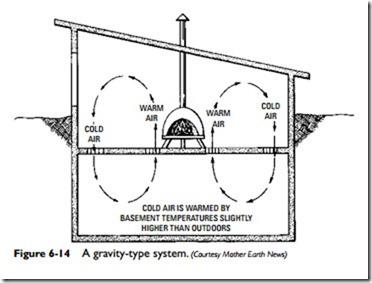Advantages of a Warm-Air Heating System
By present comfort standards, gravity warm-air heating offers no special advantage and too many disadvantages to be recommended as a heating system in the types of structures popular with the public today. The architectural design of these structures necessitates the use of a forced-warm-air heating system. Because the gravity system lacks a blower, air circulation (and therefore heat distribution) depends upon the temperature difference between the rising warm air and the descending cold air. Unfortunately, many of our houses and buildings are designed in such a way that a gravity sys- tem would require a considerable temperature difference to obtain the desired rate of air movement.
If you design the structure around a gravity heating system, then quite different results are possible. For example, a residence built by a gentleman named Wendell Thomas in western North Carolina contains a gravity-type heating system using a simple wood-burning stove that produces indoor temperatures ranging between 60 and 75°F year-round. The north and west sides of the structure were set into the ground. No windows were placed in the north wall, and the windows in the other walls were two or three panes thick.
As shown in Figure 6-14, the warm air heated by the stove rises and gives off its heat to the room. As it loses its heat, it cools and descends along the inside surfaces of the exterior walls,
passes through metal air vents in the floor, and then enters the basement where it is warmed somewhat by the slightly warmer indoor temperatures. It then rises through metal air vents placed in the floor around the stove where it is reheated and recirculated.
In a structure designed to take into consideration the operating principles of a gravity heating system, the operating costs will be lower than any other type system.
The advantages of a forced-warm-air heating system are as follows:
1. The installation costs are lower than those for hot-water or steam heating systems.
2. Heat delivery is generally quicker than other systems.
3. Heat delivery can be shut off immediately.
4. Air cleaning and filtering can be cheaply and easily provided.
5. The humidity level of the air can be easily controlled.
6. Air conditioning can be added without great difficulty or cost.
7. The furnace (because of its blower) can be placed in a number of different locations in the structure.
